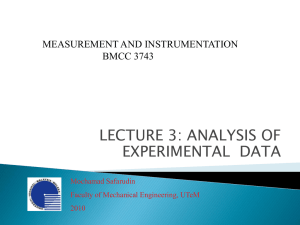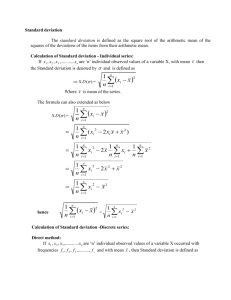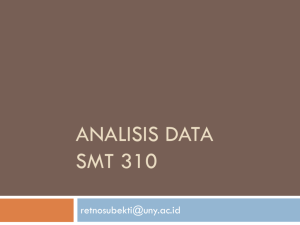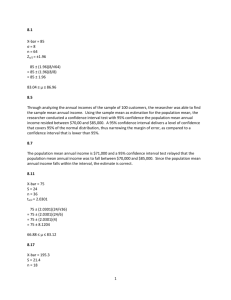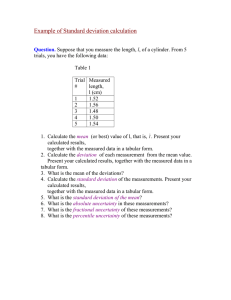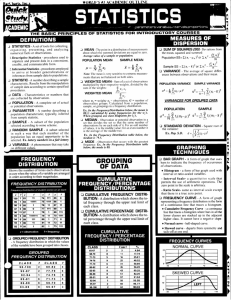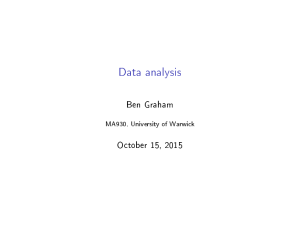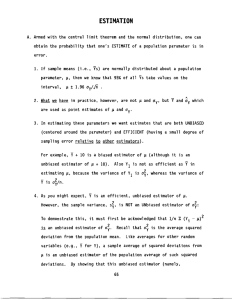Business Research Methods Chapter 17: Determination of Sample Size
advertisement
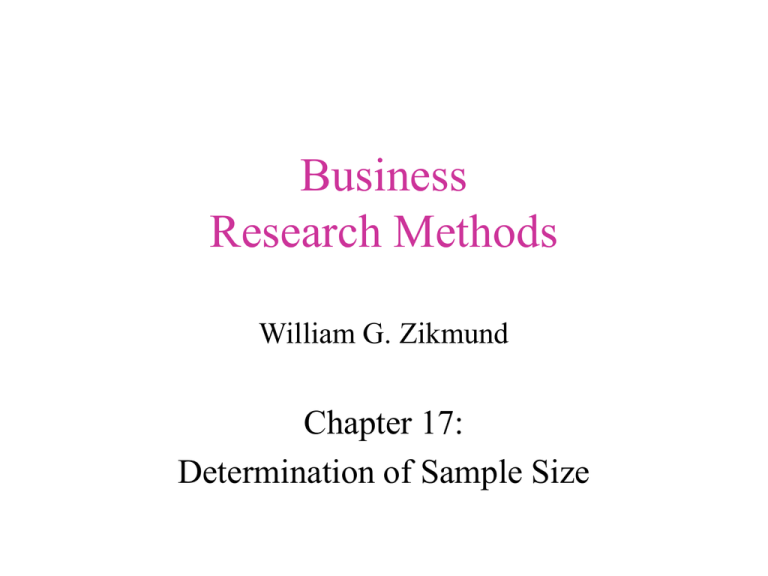
Business Research Methods William G. Zikmund Chapter 17: Determination of Sample Size What does Statistics Mean? • Descriptive statistics – Number of people – Trends in employment – Data • Inferential statistics – Make an inference about a population from a sample Population Parameter Versus Sample Statistics Population Parameter • Variables in a population • Measured characteristics of a population • Greek lower-case letters as notation Sample Statistics • Variables in a sample • Measures computed from data • English letters for notation Making Data Usable • Frequency distributions • Proportions • Central tendency – Mean – Median – Mode • Measures of dispersion Frequency Distribution of Deposits Amount less than $3,000 $3,000 - $4,999 $5,000 - $9,999 $10,000 - $14,999 $15,000 or more Frequency (number of people making deposits in each range) 499 530 562 718 811 3,120 Percentage Distribution of Amounts of Deposits Amount less than $3,000 $3,000 - $4,999 $5,000 - $9,999 $10,000 - $14,999 $15,000 or more Percent 16 17 18 23 26 100 Probability Distribution of Amounts of Deposits Amount less than $3,000 $3,000 - $4,999 $5,000 - $9,999 $10,000 - $14,999 $15,000 or more Probability .16 .17 .18 .23 .26 1.00 Measures of Central Tendency • Mean - arithmetic average – µ, Population; X , sample • Median - midpoint of the distribution • Mode - the value that occurs most often Population Mean X N i Sample Mean Xi X n Number of Sales Calls Per Day by Salespersons Salesperson Mike Patty Billie Bob John Frank Chuck Samantha Number of Sales calls 4 3 2 5 3 3 1 5 26 Sales for Products A and B, Both Average 200 Product A 196 198 199 199 200 200 200 201 201 201 202 202 Product B 150 160 176 181 192 200 201 202 213 224 240 261 Measures of Dispersion • The range • Standard deviation Measures of Dispersion or Spread • • • • Range Mean absolute deviation Variance Standard deviation The Range as a Measure of Spread • The range is the distance between the smallest and the largest value in the set. • Range = largest value – smallest value Deviation Scores • The differences between each observation value and the mean: di xi x Low Dispersion Verses High Dispersion 5 Low Dispersion 4 3 2 1 150 160 170 180 190 Value on Variable 200 210 Low Dispersion Verses High Dispersion 5 4 High dispersion 3 2 1 150 160 170 180 190 Value on Variable 200 210 Average Deviation (X i X ) 0 n Mean Squared Deviation ( Xi X ) n 2 The Variance Population 2 Sample S 2 Variance X X ) S n 1 2 2 Variance • The variance is given in squared units • The standard deviation is the square root of variance: Sample Standard Deviation S 2 Xi X n 1 Population Standard Deviation 2 Sample Standard Deviation S S 2 Sample Standard Deviation S 2 Xi X n 1 The Normal Distribution • Normal curve • Bell shaped • Almost all of its values are within plus or minus 3 standard deviations • I.Q. is an example Normal Distribution MEAN Normal Distribution 13.59% 2.14% 34.13% 34.13% 13.59% 2.14% Normal Curve: IQ Example 70 85 100 115 145 Standardized Normal Distribution • Symetrical about its mean • Mean identifies highest point • Infinite number of cases - a continuous distribution • Area under curve has a probability density = 1.0 • Mean of zero, standard deviation of 1 Standard Normal Curve • The curve is bell-shaped or symmetrical • About 68% of the observations will fall within 1 standard deviation of the mean • About 95% of the observations will fall within approximately 2 (1.96) standard deviations of the mean • Almost all of the observations will fall within 3 standard deviations of the mean A Standardized Normal Curve -2 -1 0 1 2 z The Standardized Normal is the Distribution of Z –z +z Standardized Scores z x Standardized Values • Used to compare an individual value to the population mean in units of the standard deviation z x Linear Transformation of Any Normal Variable Into a Standardized Normal Variable Sometimes the scale is stretched X Sometimes the scale is shrunk z -2 -1 0 1 2 x •Population distribution •Sample distribution •Sampling distribution Population Distribution x Sample Distribution _ C S X Sampling Distribution X SX X Standard Error of the Mean • Standard deviation of the sampling distribution Central Limit Theorem Standard Error of the Mean Sx n Distribution Mean Population Sample X S X SX Sampling Standard Deviation Parameter Estimates • Point estimates • Confidence interval estimates Confidence Interval X a small sampling error SMALL SAMPLING ERROR Z cl S X E Z cl S X X E Estimating the Standard Error of the Mean S x S n X Z cl S n Random Sampling Error and Sample Size are Related Sample Size • Variance (standard deviation) • Magnitude of error • Confidence level Sample Size Formula zs n E 2 Sample Size Formula - Example Suppose a survey researcher, studying expenditures on lipstick, wishes to have a 95 percent confident level (Z) and a range of error (E) of less than $2.00. The estimate of the standard deviation is $29.00. Sample Size Formula - Example zs n E 2 1.9629.00 2.00 2 2 56.84 2 28 . 42 2.00 808 Sample Size Formula - Example Suppose, in the same example as the one before, the range of error (E) is acceptable at $4.00, sample size is reduced. Sample Size Formula - Example zs 1.9629.00 n 4.00 E 2 2 2 56.84 2 14 . 21 4.00 202 Calculating Sample Size 99% Confidence ( 2 . 57 )( 29 ) n 2 74.53 2 2 [37.265] 1389 2 2 ( 2 . 57 )( 29 ) n 4 74 . 53 4 2 [18.6325] 347 2 2 Standard Error of the Proportion s p or p (1 p ) n pq n Confidence Interval for a Proportion pZ S cl p Sample Size for a Proportion 2 Z pq n E 2 z2pq n 2 E Where: n = Number of items in samples Z2 = The square of the confidence interval in standard error units. p = Estimated proportion of success q = (1-p) or estimated the proportion of failures E2 = The square of the maximum allowance for error between the true proportion and sample proportion or zsp squared. Calculating Sample Size at the 95% Confidence Level p .6 q .4 (1. 96 )2(. 6)(. 4 ) n ( . 035 )2 (3. 8416)(. 24) 001225 . 922 . 001225 753
